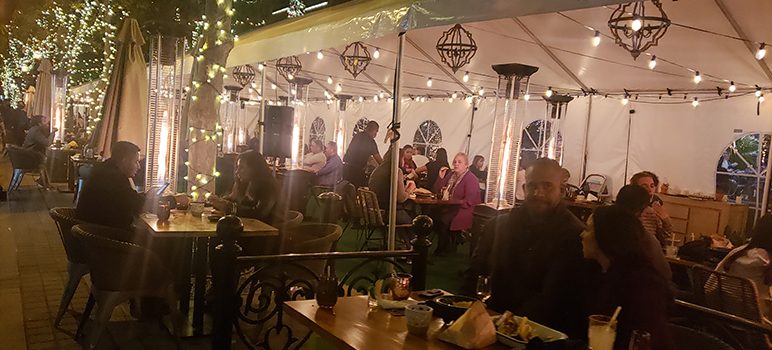Even with pandemic-safe measures like spaced-apart tables and open-air dining, Santana Row felt recklessly packed right before California’s month-long curfew went into effect.
Public health protocols that may have lessened the chance of Covid-19 contagion while diners were seated, did nothing to prevent throngs of people on Nov. 21 from brushing against each other while traversing the walkways, squeezing between restaurants and patios and dodging servers darting from one table to another.
A day earlier, local officials announced that an explosive surge in Covid-19 infections put Santa Clara County on track to exceed hospital capacity in the next few weeks.
County Public Health Officer Dr. Sara Cody’s grim forecast coincided with another from Facebook, which published an artificial intelligence-powered map of mobility data to predict a 23 percent increase in coronavirus infections by the end of the month.
That would amount to 6,607 new and 35,702 cumulative cases by Nov. 30.
But if the hustle and bustle at Santana Row this past weekend marked a sort of “last hurrah” before the state imposed new restrictions, the outlook may be even worse.
Laura McGorman, a policy manager who oversaw Facebook’s Covid-19 forecasting map as part of the company’s Data for Good Team, says the estimated uptick was based off of the preceding few weeks of mobility trends. A pre-lockdown spike in people going out, running errands or visiting friends would change the projection.
“Any predictive model is only as good as the information we put into it,” she explained. “The numbers on the map are pretty stark, showing case counts of 500 or more a day. But those numbers could shift up if people do travel for Thanksgiving or go out because they think it’s their last chance to go to the grocery store, which we try to caution against. These are things the model can’t know in advance.”
Though it can’t identify specific points of interest—like, say, Santana Row or downtown Campbell—where people congregate and heighten risk of contagion, the Facebook Covid-19 forecast is still more granular than most.
Unlike most existing insights, which tend to focus on national and state predictions or death tolls, the Facebook model uses anonymized mobility data, statistics from public agencies and proprietary symptom surveys to predict trends on a county level.
According to a Facebook spokesperson, the datasets underlying the model include confirmed case reports from state and local agencies, self-reported surveys of Covid-19 symptoms, movement range maps, mobility trends across different categories of places, doctor visits, testing and even weather.
The Facebook model’s latest projection anticipates Santa Clara County reaching a cumulative case count of 37,467 by Dec. 6..
That would be a 21 percent increase of 6,393 cases from Nov. 23.
Nationwide, the model predicts 2.7 million new cases in that same timeframe.
The highest risk jurisdictions in California, according to the map, include Los Angeles, San Bernardino and San Diego counties.
McGorman says she hopes Facebook’s predictive tool informs hospital administrators, elected leaders and public health experts as they make systemic decisions about what restrictions to impose or how to distribute ventilators and protective gear.
On an individual level, it’s at least a sobering reminder of what we’re dealing with.
“If anything,” she says, “you can look at these statistics as we head into the holiday season and remember how important it is to wear a mask, stay home and stay safe.”
Click here to take a look at the AI-powered map and here to download its raw datasets.


AI?
Can we debase ourselves a bit lower to our overlords?
Come on now…
Excel spreadsheet more like it.
Beware of your obsession with these Facebook and Google types, its not as clever as they make themselves seem to be.
People Die.
Get over it.